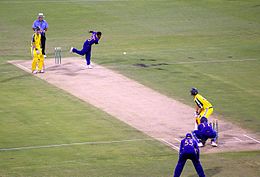
Back गेना (क्रिकेट) Bihari 투구 (크리켓) Korean ਗੇਂਦ (ਕ੍ਰਿਕਟ) Punjabi வீச்சு (துடுப்பாட்டம்) Tamil ڈلیوری (کرکٹ) Urdu
This article needs additional citations for verification. (May 2020) |

A delivery or ball in cricket is a single action of bowling a cricket ball toward the batter. Once the ball has been delivered, batters may attempt to score runs, with the bowler and other fielders attempting to stop this by getting the batters out. When the ball becomes dead, the next delivery can begin.
During the play of the game, a member of the fielding team is designated as the bowler and bowls deliveries toward the batter. Six legal balls in a row constitutes an over, after which a different member of the fielding side takes over the role of bowler for the next over. The bowler delivers the ball from their end of the pitch toward the batter standing at the opposite wicket at the other end of the pitch. Bowlers can be either left-handed or right-handed. This approach to their delivery, in addition to their decision of bowling around the wicket[broken anchor] (from the sides of the wicket on the bowler's end) or over the wicket, is knowledge of which the umpire and the batter are to be made aware.
Some forms of cricket limit the number of legal deliveries that may be bowled in each innings; for example, 100-ball cricket has a maximum of 200 legal deliveries in the game (unless there is a tie). Every delivery in a cricket match is notated by the number of completed overs that have occurred before that delivery, as well as which delivery in the current over that delivery is; for example, "Over 14.2" indicates that 14 overs have been completed and the second delivery of the 15th over is the one under consideration. Since illegal deliveries do not count towards the progression of an over, a set of consecutive illegal deliveries (and the legal delivery that follows them) will have the same notation. Illegal deliveries usually occur when a bowler bowls from too close to the batter, or delivers the ball out of the batter's reach.